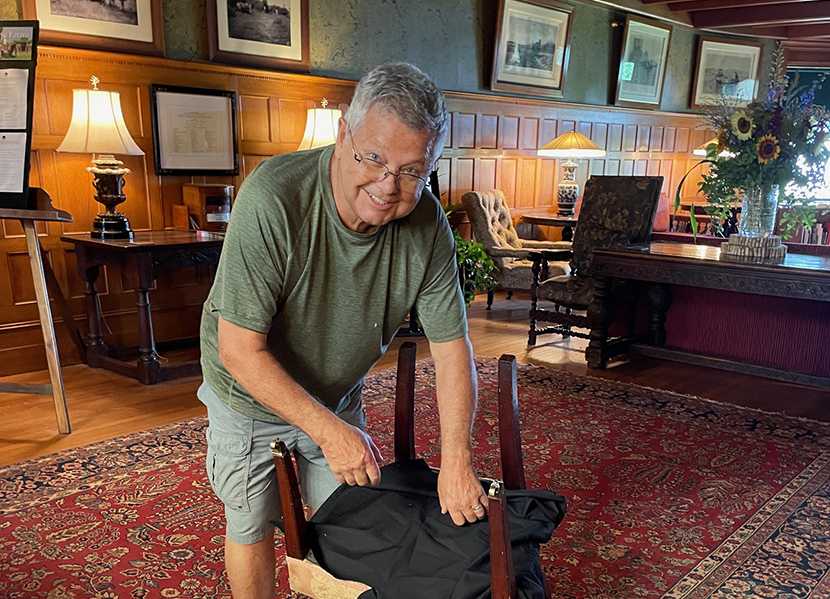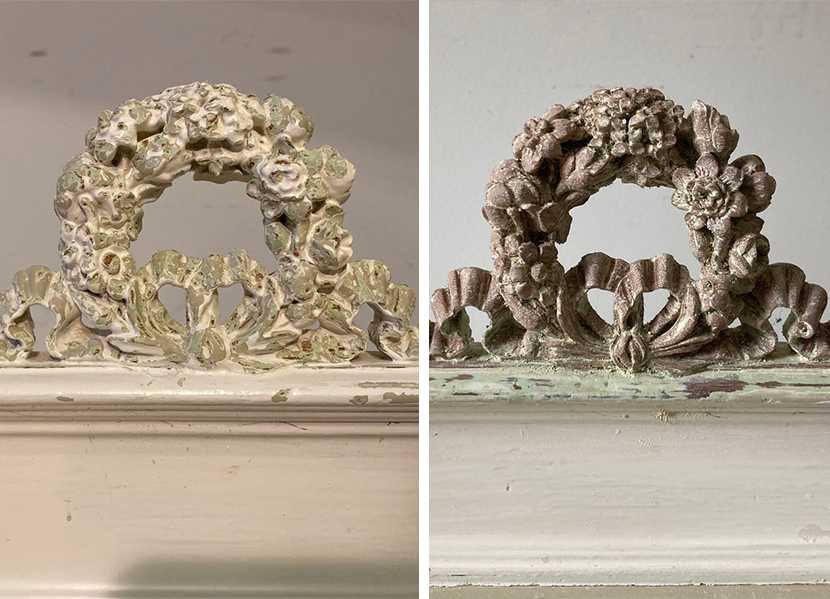I love this level of conservation for Shelburne Farms!!
The Artisans Behind the Scenes at the Inn
Shelburne Farms has long been committed to reimagining historic spaces and infusing them with new purpose. The Farm Barn is an education center and more, the north gate house is a Welcome Center & Farm Store, the Coach Barn is being rehabilitated as a gathering center for educators and the community.
Shelburne House, once a family home, was transformed into an Inn in 1987. Its original furnishings (75-80%), are not displayed as a static exhibition, but used continuously by visitors to give each person a living historic house experience. And as a sustainability practice, we maintain (repair, reupholster) what we have rather than buying new furnishings. Here’s a look at some of the artisans and the conservation projects they took on at the Inn this season to ensure the spaces will be enjoyed now and into the future.
Carolyn Frisa: Wallpaper Conservation
Carolyn Frisa is head conservator and owner of Works on Paper in southern Vermont, where she specializes in the preservation and conservation of paper. She has helped Shelburne Farms conserve a variety of objects from the collection, including framed photographs, engravings and watercolors, and wallpaper dating to 1890 and 1899.
Carolyn returned this spring to clean and stabilize the wallpaper in the corridor leading to the Marble Dining Room. In addition to cleaning the wallpaper surface with soft brushes and vulcanized rubber sponges (or "soot sponges"), she paid special attention to re-adhering the largest and loosest sections with wheat starch paste to avoid future losses. She and her studio manager Ada Brown then infilled areas of complete loss and minimized areas stained by previous water damage. "Preserving these materials for staff, guests, and visitors to use and enjoy is part of what makes working here so rewarding,” Carolyn says.
The neoclassical designed machine printed wallpaper, with white, green, and metallic decoration on a distinctive Prussian blue ground, was manufactured by F(rederick). R. Beck & Co. of New York City. Numerous Fr. Beck & Co. wallpapers were used throughout Shelburne House between 1895 and 1899. The company and its employees were well-respected for their artistry and ability to utilize modern printing techniques to create fashionable wallpapers. An 1893 article about Beck wallpapers in The Decorator and Furnisher extolled the “efforts that combine the genius of the artist with the trained skill of the practical mechanic,” and went on to say, “...and so it is that the blank roll of wall-paper is swiftly emblazoned with the most beautiful conceptions by the simple turning of the wheel.”
Judith Eisenberg: Silk Wallcovering Conservation
This season, textile conservator Judith Eisenberg treated the original crimson silk damask wall covering in the Marble Dining Room, stabilizing areas that have been damaged over time by tables and chairs. The silk was too vulnerable to repair with stitches, so she relied on an archival adhesive to secure it to newly mounted cotton fabric (see images). Future conservation will be necessary to address splitting seams.
The silk fabric was custom woven for the Marble Dining Room in August 1898 by Prelle et Cie, located in Lyon, France. Family-run since 1752, Prelle still designs and weaves silk today. The Frick Collection, the Isabella Stewart Gardner Museum, and the Biltmore to name a few have a long history of using Prelle silk on walls.
As Judith worked through the challenges with Shelburne Farms’ original silk, she fondly reminisced about tackling painted silk panels made in the 1970s by Robert Rauschenberg—perhaps one of her favorite conservation projects ever in a career spanning four decades. Prior to her recent move to Vermont, Judith ran her own textile lab in New York City. Judith enjoys projects of all sizes and while Shelburne Farms has been her largest since relocating to Vermont, she also recently completed work on a Torah mantle (cover) for Ohavi Zedek Synagogue in Burlington.
Mike Williams: Upholstery
Mike Williams has been upholstering furniture for over 40 years. He learned the trade from his father, whose business A&R Interiors was located on St. Paul St. in Burlington. (Coincidentally, Mike’s grandfather, Maurice Bushway, worked for Shelburne Farms’ dairy in the late 1950s.) Mike has a vast knowledge of fabrics, a sharp attention to detail, and a love of historic furniture—and Shelburne Farms. He literally knows our furniture inside and out –having reupholstered some pieces twice. As he tries to ease into some sort of retirement, he is selective about the projects he takes on, but this spring, he agreed to upholster the two large Empire sofas in the Tea Room, which he had last upholstered in 2014. He relished the challenge of securing the woodlands inspired fabric, “Ancient Canopy”, to the sofas' seats and backs while matching its repeating pattern. “This project has been one of my top three career favorites,” he shared.
Jennie Baker: Painted Furniture Conservation
Local conservator Jennie Baker, typically arrives at the Inn each April to work through a list of annual conservation projects. As a trained conservator, she combines her expertise in chemistry with a vast knowledge of furniture making. For over 25 years, Jennie has been instrumental in helping Shelburne Farms with a myriad of projects: she has cast new pieces to replicate losses to interior plaster moldings and gilded wood frames, repaired furniture, preserved varnished, gilded and painted wood surfaces, and provided creative and invaluable advice on a multitude of projects.
Most recently, Jennie completed the treatment of five pieces of painted furniture that were purchased as part of a suite in 1899 from Schultze, Dowling, & Butler, an interior decorating firm in New York City. A 1915 Shelburne House inventory lists many such pieces of “enameled” furniture, and over time, many have been repainted, often in different colors. During treatment, Jennie removed contemporary layers of paint to reveal early paint colors and long-obscured carved details (floral wreaths, ribbons, finials, bellflower edging), then helped us determine the proper final color and finish. “The most gratifying part,” Jennie shares, “is revealing the exquisite carving that has been obliterated under layers and layers of paint. Especially that carving on the back of the Blue Room washstand.”
We are so grateful to each skilled professional who helps us care for and maintain Shelburne Farms’ buildings and landscape. We are also grateful to the generosity of donors who have made this year's ambitious conservation/preservation projects at the Inn possible.
NOTE: As a National Historic Landmark, Shelburne Farms adheres to the Secretary of the Interior’s guidelines for the treatment of historic properties: We use the “Rehabilitation” approach to conservation, which “acknowledge[s] the need to alter or add to a historic building to meet continuing new uses while retaining the building’s historic character.”
Specifically, rehabilitation is defined as “the act or process of making possible a compatible use for a property through repair, alterations, and additions while preserving those portions or features which convey its historical, cultural, or architectural values.”












